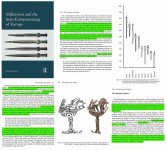Aspurg
Banned
- Messages
- 661
- Reaction score
- 233
- Points
- 0
- Ethnic group
- Bædzænæg
- Y-DNA haplogroup
- E-A24070
- mtDNA haplogroup
- I1a1a
But your sources are not valid comparison since you aren't just including ftdna. Gjenetika is voluntary and while we have a lot of personal tests with respect to frequency, there arent that many ngs tests or deeper tests beyond 37 markers comparatively.
I included only Gjenetika because your sample is large enough, I couldn't bother to go through studies and pick up these clusters individually but the percentage would have been similar. For Montenegrins the sample from the sutdy is also good at 404. And it can be seen they had good samples, because only recently some of haplotypes from that study have been appearing. I wanted more samples with STR's for Bulgarian sample so I took into account more sources.
But you are nitpicking, I remember how common are some clusters like BY4461 and FGC11450's in Arberesh study.
Secondly, you have actual studies with proper protocol from the bulgarian side (Karachanak bulgarian Y chromosome diversity for example). Their studies specifically aim to maximise penetration of as many clades as possible, so they are not gonna choose for example 26 tests to do of the Berisha clan or something like that, whereas in gjenetika this is what has happened so you get the same result many times as it is a voluntary project and many people from the same clan do the test even if there are already people of that clan.
Nope in Bulgarian regional study they only tested E-V13, others from that study were assigned to the cluster by myself because I know V13 clades so well. And I might say I made no mistakes there as some of those clusters are so well defined and they usually match Bulgarians from FTDNA.
Your own cluster is very common in Kosovo Albanians. In that study on a sample of 113, still about 12% I think were of your cluster. So your cluster is well represented in Kosovo regardless of what methodology is applied.
Secondly, a big percentage of those clades in bulgarians will be ex-albanians.
Utterly baseless based upon my analysis. I mean look: 60 % of Albanians are of those 6 clusters, you'd expect Bulgarians also to carry them to a large degree and that's not the case. In Bulgarians no cluster is that significant which is in line with high diversity there.
All the contemproary linguists, even matzinger who argues for Albanian language not being illyrian but balkan hinterland language, says that proto-Albanian does not fit thracian.
Well from some things I read it doesn't indeed.
You seem to be pushing for thracian as proto-Albanian, but what is your linguistic evidence for this?
No, I don't. I know many spoke on that topic, but there are numerous problems for that. Someone better try looking at Orel's proto-Albanian and compare that to Illyrian, Thracian etc. Albanian might have some connection to some other languages potentially too. How about some Paeonian connection?
At poreklo (and by some Serbian linguists I might add) Thracian theory is pushed to make Albanians into migrants. So that Slavs/Serbs have been there before Albanians.


